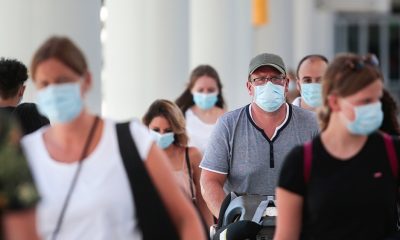Covid-19
Contra Costa Health officials to impose new restrictions as COVID-19 cases rise
Contra Costa County, California – With data from the past week showing a marked increase in COVID-19 cases and hospitalizations in Contra Costa County, health officials are taking steps to protect the community with modest changes to local health orders.
Contra Costa entered the orange tier of California’s Blueprint for a Safer Economy on Oct. 27, triggering an expansion of community reopening activities in the county. But since that date, the average daily number of new cases in the county has grown substantially higher.
If the trend continues, the county is at risk of moving backward into the more-restrictive red tier of the state’s reopening plan as soon as next week. In the meantime, Contra Costa has amended its health orders to rein in some of the riskier indoor activities permitted under the orange tier in hopes of preventing outbreaks and keeping the county out of the red.
Contra Costa County’s health officer issued new orders today limiting the number of spectators allowed at professional and collegiate sporting events, while also reimposing restrictions on other high-risk activities.
The health order on sporting events limits the number of spectators at pro or college games to 25 people from no more than three different households. This is consistent with the County’s guidance on private social gatherings, said Dr. Chris Farnitano, the County’s health officer.
Increased restrictions
The health officer also issued another order restoring stricter limitations on high-risk activities, such as prolonged indoor gatherings and gatherings involving eating and drinking where masks must be removed. Wearing face coverings when around others from outside your household is one of the most effective ways people can stop the spread of COVID, Dr. Farnitano said.
Under the new order, select high-risk activities must be modified:
- Outdoor bars prohibited (except where allowed under restaurant guidance with drinks as part of a meal)
- Indoor dining allowed at a maximum of 25% occupancy or 100 people, whichever is fewer (down from 50% occupancy and 200 people)
- Indoor movie theaters can operate at a maximum 25% of occupancy or 100 people, whichever is fewer (down from 50% occupancy or 200 people)
- Religious services indoors allowed at a maximum 25% occupancy or 100 people, whichever is fewer (down from 50% occupancy or 200 people)
- Cardrooms and satellite wagering sites can’t operate indoors (they previously could operate indoors at 25% capacity)
“We believe these measures are necessary to reduce the spread of COVID in our community,” Dr. Farnitano said.
Changes begin Friday, Nov. 6
The state allows counties to impose stricter standards so local health departments can respond to circumstances in their communities. The order in Contra Costa will go into effect Friday, Nov. 6. Over the past months, the Bay Area counties have made the decisions they’ve felt best around opening or not opening businesses and activities. San Francisco pulled back on their timeline for opening last week. Alameda and Santa Clara have all taken a slower pace than the state tier system allows. All three of these counties are essentially operating at red tier level restrictions even though they are in orange or yellow tiers.
Contra Costa County is still in the orange tier, but case rates are increasing again into the more restrictive red-tier level. The most recent data show an adjusted rate of 4.9 daily cases per 100,000 people in Contra Costa – above the orange-tier benchmark of fewer than 4 per 100,000 people.
If those numbers hold for another week or increase, Contra Costa will move back into the more restrictive red tier.
In addition, there were 40 people hospitalized on Nov. 2 due to COVID in local hospitals, compared to a low point of 17 in mid-October.
For now, other activities not cited in the new order will still be allowed under orange-tier criteria. This includes indoor swimming pools and indoor family entertainment centers which can continue “naturally distanced” activities, such as bowling alleys, escape rooms and climbing-wall gyms, at 25% occupancy.






















